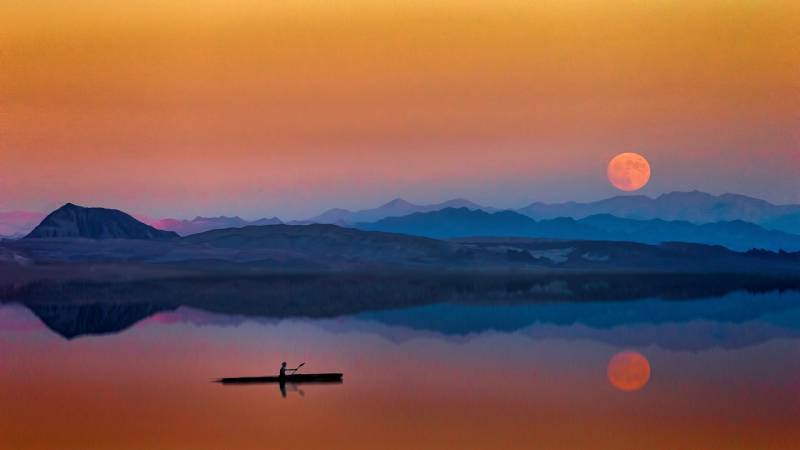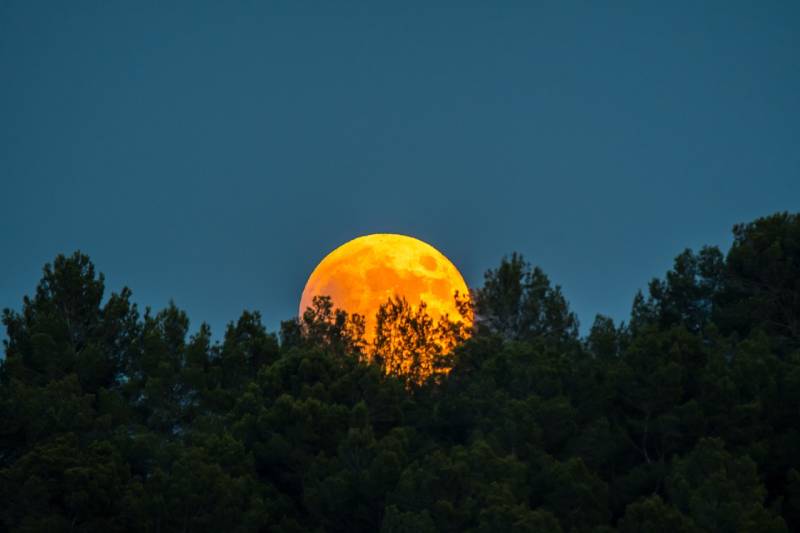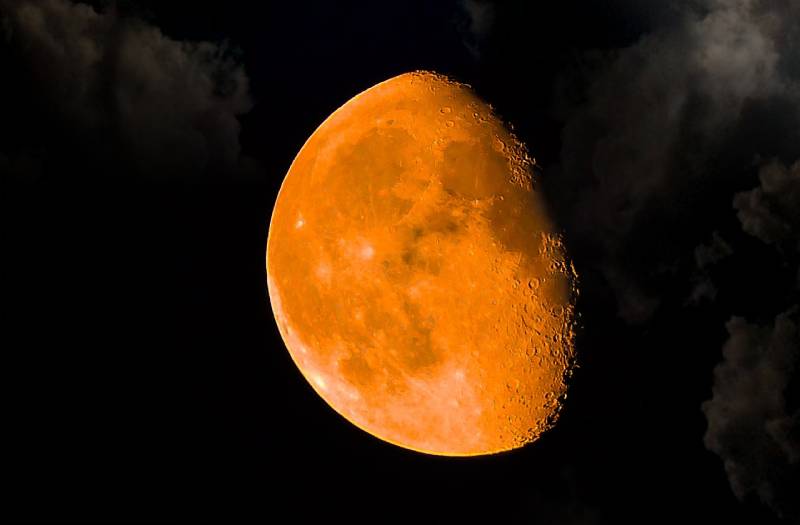The Moon completes its orbit around the Earth every 29.5 days, shifting between four lunar phases as it completes its journey. Each of the Moons phases, from the new Moon to the full Moon, represents different points in its orbit around our planet.
Look up at the Moon, and you might notice it differs in size, color, and brightness as it travels around the globe. Why is the moon orange at times, and what causes this phenomenon?
What Causes the Moon to Appear Orange?
Scientists believe the Moon appears orange from the Earth’s surface for two reasons. Let’s unpack each of them in detail.
The Atmosphere
The lunar surface appears grey when astronauts and satellites view the Moon from outside Earth’s atmosphere. However, depending on where you are on the Earth and the position of the Moon in the sky, the lunar surface can appear red, yellow, orange, or white.
The Moon looks orange when it appears closer to the horizon. At this angle, the light reflecting off the lunar surface travels through a thicker layer of atmosphere than when it’s high in the night sky. When moonlight travels through the atmosphere, the short wavelengths of green, blue, and violet scatter, and the longer wavelengths, orange, yellow, and red, are visible.

The thicker the atmosphere, the more reddish tint the moonlight has to it. During sunset and sunrise, the Sun’s vivid colors change. The last time you saw a sunset, it might have appeared red, orange, or pink. This color variation is due to light passing through Earth’s atmosphere, scattering the wavelengths.
When the Sun is high in the sky, there’s less atmosphere filtering the sunlight, making it appear yellow or white. When observing an orange moon, you might notice that Earth’s Satellite appears bigger than normal. This phenomenon is known as a “Moon illusion.” However, it’s all a visual trick, as the Moon remains the same distance from Earth throughout its orbit.
Air Pollution
The second reason for the appearance of an orange moon is pollution. Smoke, dust, and other pollutants add molecules to the atmosphere, intensifying the scattering effect on moonlight. As a result, the Moon appears reddish-tinted, and it can happen even when the Moon is high in the night sky.
The color of the smoke in the atmosphere only has a minimal impact on the color of the sky. In most instances, fresh smoke doesn’t produce the same visual effect. For example, campfire smoke appears blue/gray in the sunlight or moonlight.
What is the Orange Moon Called?
During the Summer Solstice, the Moon is lowest in the sky, and the Sun is highest. The days leading up to and following the summer solstice see the Moon run low in the night sky for those observing it from the Northern Hemisphere.
The Moons low position on the horizon makes it more likely to appear orange during sunset and even more prominent when there’s a full Moon.
The Harvest Moon
The orange Moon is also known by the moniker “The Harvest Moon“. This event occurs during the full Moon before the Autumnal Equinox, known as the first day of fall in the Northern Hemisphere. During this time, the Moon rises at nearly the same time as the Sun sets and appears orange in color when it’s at the horizon.
The orbit of the Moon is nearly parallel to the horizon on Earth for the duration of the Harvest Moon event. The Harvest Moon gets its name from the additional light it casts onto the Earth’s surface. This effect assisted farmers and agricultural communities with harvesting well into the night to prepare for the winter ahead.

The Harvest Moon gets its name from Native American tradition, which tribes shared with European settlers in the Americas. Typically, the Harvest Moon occurs during September or October. The date of the Harvest Moon depends on which month has a full Moon closest to the Autumn Equinox.
If the event occurs in September, it’s known as the Harvest Moon,” and if it occurs in October, it’s called the “Corn Moon.” Due to the history behind the Harvest Moon, many people associate it with the end of the summer and the start of winter.
The Hunters Moon
Some people may call an orange Moon the “Hunters Moon.” This event occurs when the full Moon crosses the horizon at sunset and appears orange.
Similar to the Harvest Moon, the Hunters Moon got its moniker from the changing of seasons and the start of the hunting season after deer and other animals had a chance to fatten up over the summer.
The additional light cast on the Earth’s surface during the Hunter’s Moon made it easier for Hunters to shoot prey at night.
How Did the Harvest Moon & Hunters Moon Get Their Names?
Agricultural communities throughout history relied on the Moon to signal stages of the planting and harvesting cycles in fields. For instance, the New Moon in the first quarter is when the fields are wet, fertile, and suitable for planting.
The full Moon in the last quarter is the ideal time for thinning, mowing, pruning, weeding, and planting crops below ground. Native American tribes used the first orange Moon around the Autumn Equinox as a sign of the start of winter.
Thus, the Native Americans called this event the Harvest Moon to signal when to harvest their corn crops. Since the Harvest Moon follows closely after sunset, it creates more moonlight in the fields, giving the Native Americans additional time to extend their harvest duties.
The Algonquin Native American tribes called the orange Moon occurring in October the Hunters Moon and also the “Strawberry Moon” because it signaled the time to start the hunting season in preparation for the coming winter.
The Final Thought – Is the Orange Moon Called a Blood Moon?
No. An orange moon is not called a “Blood Moon.” The Blood Moon occurs when the lunar surface appears red. The Blood Moon is a rare occurrence, just like the orange Moon, and it only happens a few times during the year.
The best chance of seeing a Blood Moon is during a total lunar eclipse when the Moon is full. During this time, sunlight bends around the Earth, allowing longer red wavelengths to reflect on the lunar surface, making the Moon appear red in the night sky.

